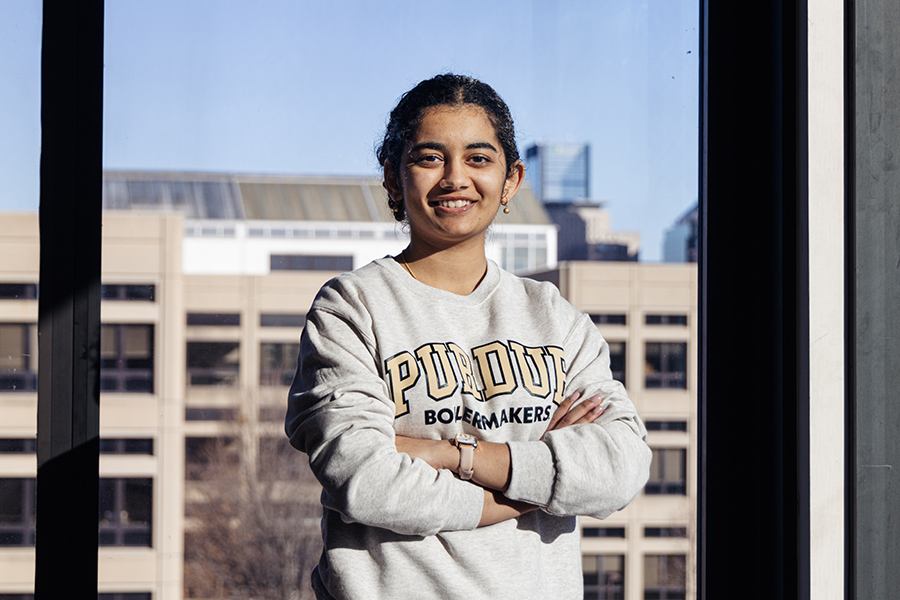Student Mukadam Creates Medical Undergrad Communities for Purdue University in Indianapolis

Ishita Mukadam’s interest in biomedical engineering research started when she scraped her knee at 12 years old.
On a trip to India, Mukadam watched as her grandmother used turmeric on the wound. That was different from how the spice was used in the girl's kitchen in Fairfield, Iowa. Her grandmother’s reasoning was simple: It was what her mother put on her scraped knees.
But Mukadam wanted to find the scientific answer, even at 12. In the next few years, she would see incredible medical technology, like a mannequin-simulated birth, and try her hand at suturing a wound firsthand in a university workshop. If such simulations existed, someone had to have performed one on a wound with turmeric.
When the research came up empty, then-14-year-old Mukadam decided it was up to her to explore the connection.
“I found that numerous studies had been done on (turmeric and) blood clotting,” Mukadam said. “But none focused on wound infections. There's about 8 million people around the world dying from infection-related causes each year, so I decided to merge my interest in turmeric with the issue of wound infection.”
Mukadam, a high school student at the time, used the pH-sensitive property of turmeric to create an infection-detecting bandage. Through the simulations, she demonstrated that the color change of turmeric, which occurs when an infection develops, would allow for life-saving intervention.
Her high school research would eventually lead her to Purdue University in Indianapolis, majoring in biomedical engineering (BME) and studying as a First Time Researcher Fellow with a Trustee Scholarship award in 2024.
“Eli Lilly and Company, Cummins, Cook Medical and many biomedical companies are right by campus,” said Mukadam, a first-year student. “I had only heard of these names before Purdue, and in the first few months in Indianapolis, I talked to most of them through classes. I'm now working in a lab setting with chronic kidney disease detection using bone health with people striving for PhDs and postdocs. Already I'm able to explore industry, research and medical school paths to see which one I might like the most.”
In the fall of 2024, Mukadam began an internship at Neurava, which creates wearable devices that monitor for epileptic seizures and send alerts when a user needs medical intervention. The baseline goal of the project is to save lives through access, one of Mukadam’s passions when she created the turmeric bandage. Her drive to save lives led her to work with peers to pursue adding an Engineers Without Borders chapter at Purdue in Indianapolis. She serves as vice president.
Within the same semester, she created a community for students interested in medicine to find opportunities without needing to scour for them.
“I realized if I'm interested in healthcare, I might as well help bridge the gap between medicine and the Indianapolis campus,’” she said. “That’s the goal of the Purdue in Indianapolis Medical Association (Pi-Med): to intersect educational medical resources with engineering curriculum for students.”
Mukadam is the founder and president. She contacted Sharon Miller, assistant vice provost for Purdue University in Indianapolis and associate professor of engineering practice in the Weldon School of Biomedical Engineering, to be the faculty advisor and for assistance in drafting the organization’s constitution.
Mukadam’s goal is to start “a robust footprint for BME in Indianapolis,” according to Miller. Through one-on-one monthly meetings, Mukadam and Miller create events for students with an interest in healthcare and medicine, regardless of major.
The Pi-Med constitution states a mission of educating students in medicine and healthcare fields through knowledge of resources and professional connections.
Members interact with BME professionals regularly through volunteering at on-campus summits, such as the Fourth Annual Health Summit in February 2025, and hosting networking panels throughout the academic year. Leadership consists of other first-year students like Mukadam with a passion for research and sharing opportunities.
“The integration of all these healthcare resources on Purdue’s campus is what brought me to Indianapolis,” Mukadam said. “It’s important for people to be aware of these resources, which is part of the reason for Pi-Med’s founding. My friends and I are committed to bringing these biomedical, healthcare and engineering resources to students on this campus. I know we’re ready to put in the work needed to make it happen.”
Miller expressed admiration for Mukadam’s tireless spirit and her willingness to create experiences for her peers and future students. “Ishita brings eagerness and excitement that really excites faculty and staff in biomedical engineering. She exudes vibrant ambition, which she uses to capitalize on all the resources that she and her peers can use in Indianapolis.”
